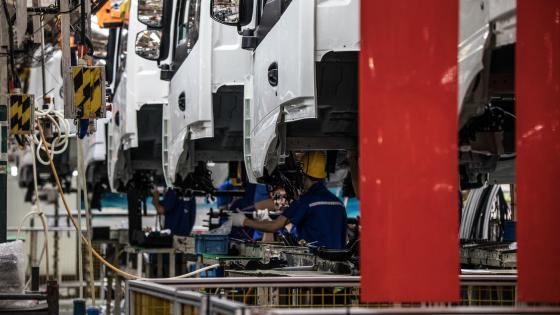China is the archetype of an economy that is well integrated into global production chains. It imports raw material, equipment, and other intermediate inputs, and then exports 37% of its output to the world market (in 2006), which is huge when compared to the United States (8%) or India (13%). With the reputation of a “world factory,” China is a top supplier of manufacturing outsourcing for many global companies.
Imported inputs used in the production of exports reduce the share of value added generated by domestic producers. Consider the example of the iPod, which China assembles for Apple and exports to the United States and other countries. In trade statistics, the Chinese export value for a unit of a 30GB video model in 2006 was about $150. However, Linden, Kraemer, and Dedrick (2007) estimated the value added attributable to producers in China at only $4.
Why do we care?
For many policy issues, it is important to assess the extent of domestic content in exports. For example, what is the effect of a currency appreciation on a country’s exports? The answer depends crucially on the share of domestic content in the country’s exports. Other things equal, a given exchange rate appreciation would have a smaller effect on trade volume, the lower the share of domestic content in the exports.
As a second example, what is the effect of trading with China on European income inequality? The answer depends in part on whether China simply exports products that are intensive in low-skilled labour or whether China’s exports are more sophisticated. Dani Rodrik has noted that the per capita income typically associated with the kind of goods bundle that China exports is much higher than China’s actual income. He interprets this as evidence that the skill content of China’s exports is likely to be much higher than its endowment may imply. Peter Schott has documented an apparently fast increase in the similarity between the Chinese export structure and that of high-income countries, and interprets it as evidence of a rise in the level of sophistication embedded in Chinese exports. However, if the domestic content in China’s exports is low, especially in sectors that would have been considered sophisticated or high-skilled in the United States, then imports from China may still generate a large downward pressure on the wage of the low-skilled Americans after all (as pointed out by Paul Krugman).
The existing formula
Hummels, Ishii, and Yi (2001) proposed a concept of vertical specialisation in a country’s trade, defined as "the imported input content of exports, or equivalently, foreign value added embodied in exports," and provided a formula to compute vertical specialisation share based exclusively on a country’s input-output table. However, a key assumption needed for their formula to work is that the intensity in the use of imported inputs is the same between production for exports and production for domestic sales.
This assumption is violated in the Chinese case due to pervasive processing exports. Processing exports are characterised by imports for exports with favourable tariff treatment: firms import parts and other intermediate materials from abroad, with tariff exemptions on the imported inputs and other tax preferences from local or central governments, and, after processing or assembling, export the finished products to the international market. The policy preferences for processing exports usually lead to a significant difference in the intensity of imported intermediate inputs in the production for processing exports and in other productions. Since processing exports have accounted for more than 50% of Chinese exports every year at least since 1996, the Hummels, Ishii, and Yi formula is likely to lead to a significant under-estimation of the share of foreign value added in its exports.
A new formula
To compute shares of foreign and domestic value added in a country’s exports when processing exports are pervasive, we developed a general formula, for which Hummels, Ishii, and Yi’s is a special case (Koopman, Wang, and Wei 2008). We account for the possible difference in the intensity of imported intermediate inputs in the production for processing exports and in other productions by expanding the standard input-output (I/O) table with a separate account for processing exports, and domestic sales & normal exports.
However, this formula is not directly applicable as some of the input-output coefficients called for are not generally available from conventional I/O tables. We therefore developed a mathematical programming method to estimate these coefficients by combining information from trade statistics (which separate processing and normal trade) with standard I/O tables. To be precise, we use information from an I/O table to determine sector-level total imports/exports, and information from trade statistics to determine the relative proportion of processing and normal exports within a sector.
Chinese value added
We applied our methodology to the Chinese data for 1997, 2002, and 2006 and found that the share of foreign value added in Chinese manufactured exports is at about 50%, almost twice as high as that implied by the Hummels, Ishii, and Yi (HIY) formula, as can be seen in Table 1.
Table 1 Shares of domestic and foreign value added in total exports (%)
|
|
The HIY Method
|
The KWW Method
|
|
|
1997
|
2002
|
2006*
|
1997
|
2002
|
2006*
|
|
All Merchandise
|
|
|
|
|
|
|
|
Total Foreign value-added
|
17.6
|
25.1
|
26.3
|
47.7
|
46.1
|
49.3
|
|
Direct foreign value-added
|
8.9
|
14.7
|
15.7
|
46.1
|
42.4
|
45.7
|
|
Total Domestic Value-added
|
82.4
|
74.9
|
73.7
|
52.3
|
53.9
|
50.7
|
|
Direct domestic value-added
|
29.4
|
26.0
|
25.3
|
23.7
|
20.1
|
19.2
|
|
Manufacturing Goods Only
|
|
|
|
|
|
|
|
Total Foreign value-added
|
19.0
|
26.4
|
27.1
|
52.4
|
48.7
|
50.6
|
|
Direct foreign value-added
|
9.7
|
15.6
|
16.3
|
50.9
|
45.0
|
47.0
|
|
Total Domestic Value-added
|
81.1
|
73.6
|
72.9
|
47.6
|
51.3
|
49.4
|
|
Direct domestic value-added
|
27.5
|
24.6
|
24.6
|
21.2
|
18.5
|
18.4
|
Notes: The HIY method refers to estimates from using the approach in Hummels, Ishii, and Yi (2001). The KWW method refers to estimates from using the approach developed by us that takes into account special features of processing exports. The estimates for 2006 are preliminary as they use the trade statistics in 2006 but the I/O table in 2002, which is the latest available. The next (2007) benchmark table is scheduled to be released in 2010.
We also estimated that the share of foreign value added in normal exports is way lower (between 5-11%) than in processing exports (between 74-82%). There are also interesting variations across sectors and firm ownership. Those sectors that are likely labelled as relatively sophisticated such as computers, telecommunication equipments, and electronic devices have particularly high foreign content (about 80%). Moreover, foreign-invested firms also tend to have higher foreign content in their exports than do Chinese domestic firms, as can be seen in Table 2.
Table 2 Shares of domestic value added in exports, by firm ownership (%)
|
|
Share of Total Domestic Value-added
|
Share of Direct Domestic Value-added
|
Share of processing exports in total exports
|
Share of exports by firm ownership in China's total exports
|
|
2002
|
|
|
|
|
|
Wholly Foreign Owned
|
32.6
|
14.2
|
87.9
|
29.4
|
|
Joint Venture Firms
|
44.1
|
16.4
|
71.0
|
22.6
|
|
State Owned Firms
|
69.7
|
25.2
|
31.8
|
37.9
|
|
Collectively Owned Firms
|
72.3
|
24.5
|
28.1
|
5.8
|
|
Private Firms
|
83.7
|
28.3
|
8.7
|
4.3
|
|
All Firms
|
53.8
|
20.1
|
55.9
|
100.0
|
|
2006*
|
|
|
|
|
|
Wholly Foreign Owned
|
27.8
|
13.3
|
85.3
|
39.3
|
|
Joint Venture Firms
|
44.8
|
17.5
|
63.1
|
|
|
State Owned Firms
|
70.0
|
24.6
|
27.1
|
19.8
|
|
Collectively Owned Firms
|
70.9
|
24.2
|
24.7
|
4.3
|
|
Private Firms
|
82.0
|
27.4
|
10.3
|
18.0
|
|
All Firms
|
50.9
|
19.3
|
53.6
|
100.0
|
Note: The estimates for 2006 are preliminary as they use 2006 trade statistics but the 2002 I/O table, which is the latest available. The next (2007) benchmark I/O table is scheduled to be released in 2010.
Conclusions
Our best estimate suggests that the share of domestic content in China’s exports is about 50%, which is much lower than most other countries. This implies that a given exchange rate appreciation is likely to have a smaller effect on China’s trade surplus than for other countries. The domestic content share is particularly low in sectors that are likely to be labelled as sophisticated, such as electronic devices and telecommunication equipments. This means the competitive pressure China’s exports place on skilled workers in high-income countries is smaller than suggested by a simple-minded look at the raw trade data. Applying our methodology to exports from countries in Central and Eastern Europe or South Asia might raise similarly important findings.
References
Hummels, D., J. Ishii and K. Yi. 2001. “The Nature and Growth of Vertical Specialization in World Trade,” Journal of International Economics 54:75-96
Koopman, Robert, Zhi Wang, and Shang-Jin Wei (2008) “How Much of Chinese Exports is Really Made In China? Assessing Domestic Value-Added When Processing Trade is Pervasive” NBER Working Paper 14109
Linden, Greg, Kenneth L, Kraemer, and Jason Dedrick, 2007, “What Captures Value in a Global Innovation System?” The Paul Merage School of Business, UC Irvine, working paper.



